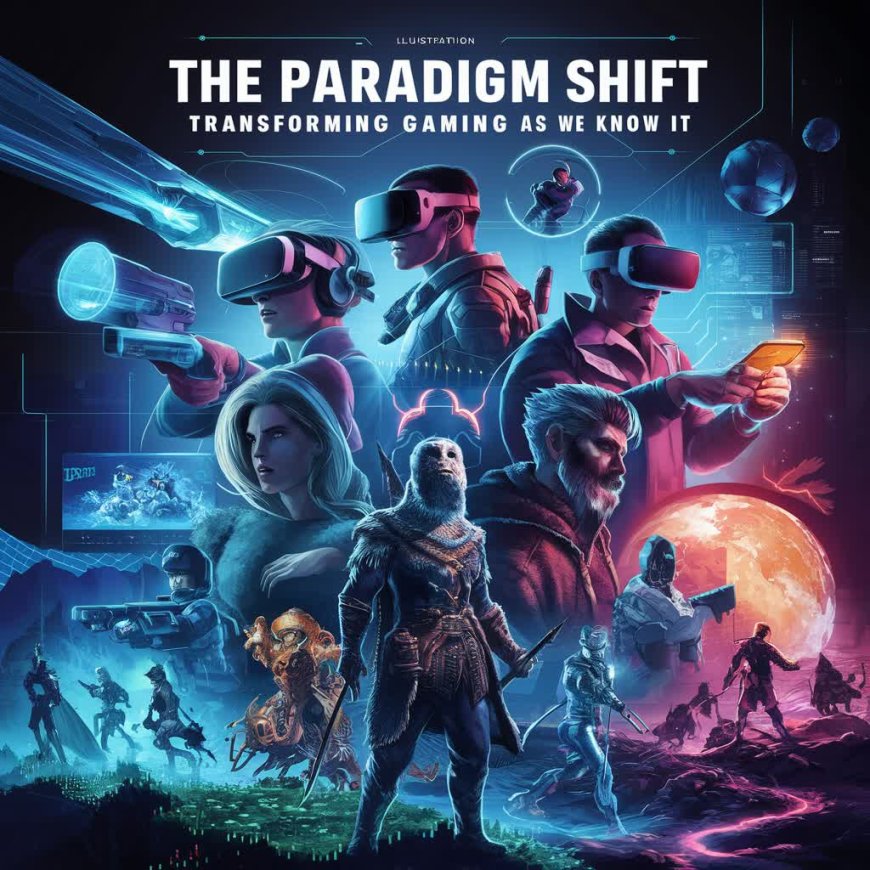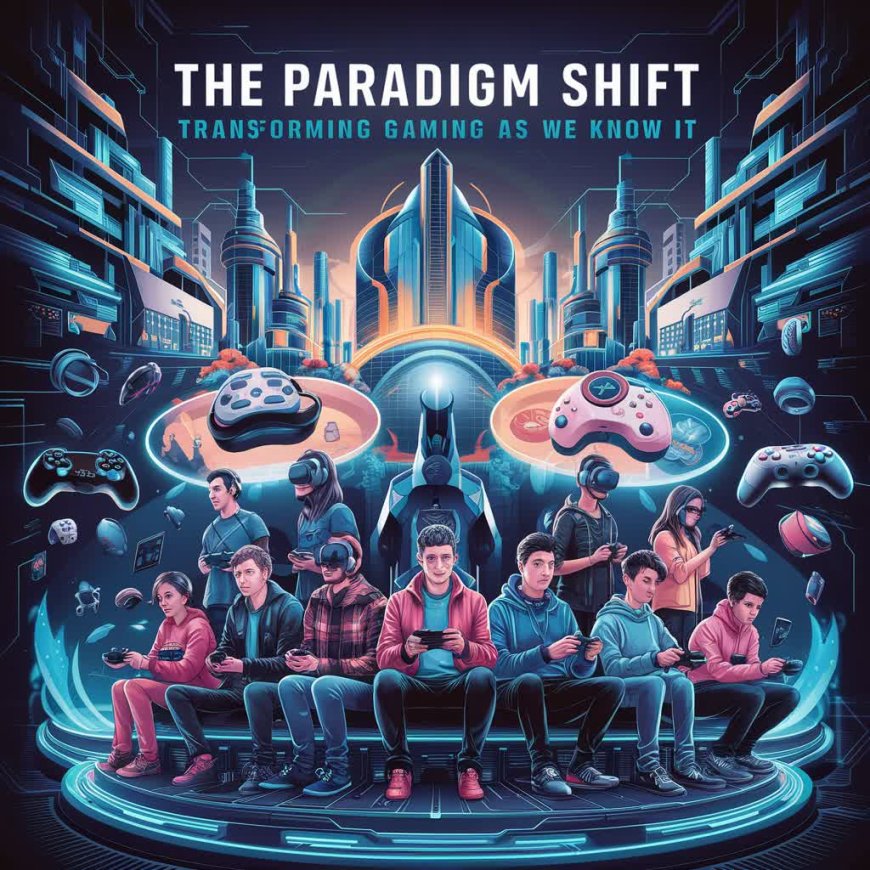The Paradigm Shift Transforming Gaming as We Know It
Explore the transformative trends redefining the gaming world and reshaping how we interact with digital entertainment. From cloud gaming to personalized experiences, this article delves into the technological advancements and innovative strategies changing the landscape of game development, player engagement, and industry growth. Discover how the gaming industry is adapting to meet evolving player expectations, fostering creativity, and building immersive experiences that are accessible, engaging, and community-driven. Join us in examining this paradigm shift and its impact on the future of gaming.
The Paradigm Shift Transforming Gaming as We Know It
In my many years of observing the gaming sphere, I’ve seen a plethora of trends rise and fall, each leaving an indelible mark on the way we immerse ourselves in digital worlds. Yet, a singular movement has surfaced, one with the power to redefine the entire landscape of gaming: the advent of cloud gaming. This isn’t merely a new method of game streaming; it represents a seismic change in how games are accessed and experienced. Cloud technology allows players to delve into high-quality titles on an array of devices, bypassing the need for costly hardware or cumbersome downloads. The ramifications of this shift are profound, democratizing gaming for underserved regions and reshaping financial dynamics for developers. In this article, I delve into how cloud gaming is reshaping player experiences and the strategic approach of developers and publishers alike. Through exploring its advantages, hurdles, and future impact, it becomes evident that this trend transcends a mere novelty—it’s a transformational force poised to redefine the future of gaming.
Adaptive Development: Streamlining Game Creation at Scale
From my perspective, adaptive development has become a game-changer, enabling swift yet efficient game production by aligning resources with project needs. This elasticity in development not only refines workflows but also catalyzes synergy among team members. By leveraging modular design concepts, game components can be crafted concurrently, accelerating iteration and feedback cycles. I’ve witnessed how this adaptable framework keeps the creative process in constant motion, fostering innovation without succumbing to rigid timelines.
Additionally, the focus on customization within scalable development permits a more individualized gaming journey. With frameworks supporting scalable growth, developers can seamlessly incorporate diverse elements that honor original intellectual property. This paradigm enriches gameplay while upholding industry standards of respect for creative contributions. Ultimately, this trend positions creators to deliver immersive, engaging experiences while upholding ethical standards.
Accelerated Development Speeds: Meeting Modern Demand
Accelerated development practices have considerably reduced game production timelines, to the benefit of both creators and gamers. With the advent of advanced tools, teams can swiftly prototype and test concepts, fostering a fluid iteration process. This expeditious approach conserves valuable time and ensures that the final product resonates with its target audience. The capacity to swiftly pivot in response to feedback has cultivated a culture of refinement, enabling the quick incorporation of new ideas and adjustments.
Enhanced collaboration has redefined team interactions in this rapid-paced environment. When all members contribute in real-time, it promotes a vibrant and engaging workspace. I’ve observed that this collaborative momentum enhances the respect for intellectual property, creating games that are not only inventive but also anchored in a rich legacy of gaming.
Enhanced Collaboration Redefines Team Dynamics
In a collaborative setting, the synergy of shared insights and experiences ignites a rich tapestry of ideas, each tailored to resonate with diverse player preferences. This collaborative atmosphere nurtures scalable development, enabling teams to iterate on successful concepts while maintaining a cohesive project vision.
This transformative collaboration fosters an environment where open communication and mutual respect flourish. Having participated in such team dynamics, I’ve witnessed firsthand how effective collaboration tools dismantle silos, empowering cross-functional teams to engage wholeheartedly. This dynamic not only uplifts morale but also enhances accountability, as each member feels invested in the success of the project. Ultimately, the synergy created through such collaboration elevates the gaming experience and establishes a new benchmark for game development.
Unleashing Creativity through Ideation
Ideation has proven invaluable as a catalyst for groundbreaking ideas within gaming. By fostering brainstorming sessions that prioritize innovation, fresh perspectives often emerge from unexpected places. This process cultivates an energized environment, tapping into the diverse backgrounds and talents of team members, enabling unique narratives, gameplay mechanics, and visuals that deeply resonate with players.
The iterative nature of ideation allows for the continuous refinement of these concepts, paving the way for enhanced collaboration throughout the development process. Through this feedback-driven cycle, game designs emerge more polished and engaging, ultimately accelerating production. Respecting intellectual property within ideation ensures that novel ideas thrive without compromising the integrity of existing works, promoting an industry culture of respect and creativity.
Personalization: Crafting Unique Gaming Experiences
Personalization in gaming has revolutionized how players engage, making each journey uniquely tailored. The ability to customize aspects from character designs to gameplay mechanics enables players to forge a deeper bond with the game world. This heightened engagement fosters satisfaction, inviting players to invest both time and emotional connection into their experiences. With scalable development practices, personalization can be extended across platforms, ensuring players feel valued regardless of their preferred medium.
Prioritizing personalization also instills a sense of ownership among players, amplifying immersion. In my experience, this approach bolsters player loyalty and strengthens community engagement. As innovation continues to steer game design forward, blending personalization with a commitment to respecting intellectual property will produce gaming experiences that are both inclusive and compelling.
Respecting Intellectual Property: Building a Foundation of Trust
Respecting intellectual property has emerged as essential for cultivating trust within the gaming ecosystem. When studios honor the rights of original creators and safeguard innovations, it fosters an atmosphere of authenticity. Players are more inclined to invest in titles from studios that uphold ethical standards, assured that their beloved games are crafted from genuine creativity rather than imitation. This commitment to integrity not only cements long-term developer-player relationships but also promotes collaborative innovation as creators feel secure sharing unique ideas.
In my experience, an environment that respects intellectual property enhances collaboration among developers, artists, and writers, fueling a spirit of creativity and innovation. This ethos is invaluable as gaming continues to thrive on diverse perspectives, enabling us to produce richer, more personalized experiences that resonate deeply with players.
Collaboration Tools: Streamlining Game Development
The integration of collaborative tools has fundamentally reshaped game development, amplifying productivity and creativity. These tools support scalable workflows, enabling teams to collaborate seamlessly across locations. Real-time communication, project management, and asset sharing facilitate accelerated production by reducing time spent on revisions and avoiding miscommunication. This newfound efficiency nurtures an environment where ideas flourish, leading to richer gameplay and more customized content for audiences.
Moreover, collaborative tools enhance brainstorming sessions, enabling the seamless exchange of concepts and feedback in a shared digital space. This synergy fosters a culture of ingenuity, where team members push creative limits. Consequently, our games capture the collective vision of the team and resonate with players, integrating their insights into our development approach. The marriage of technology with creative expression results in gameplay that respects both player expectations and our artistic integrity.
Adaptability: Embracing Evolution in a Rapid Industry
In a constantly evolving industry, adaptability is critical. Scalability ensures that teams can pivot swiftly in response to market trends, whether by expanding resources or embracing innovative technology. This adaptability allows projects to remain relevant, enabling experimentation with features that captivate audiences, and aligning creativity with prevailing industry trends.
Respect for intellectual property is equally crucial as scalable solutions are implemented. Through robust systems, we protect creative assets while fostering productive partnerships. This equilibrium between innovation and integrity is the foundation of success, creating experiences that remain impactful over time.
Faster Development: Satisfying the Demand for Rapid Turnaround
Accelerated game development aligns with today’s expectations for rapid content delivery, enabling quicker releases without sacrificing quality. Enhanced teamwork across departments underpins this progress. Using cloud platforms and agile methodologies, we streamline communication, ensuring alignment with project goals. This unity allows for rapid responses to player feedback, refining products to align with evolving player desires.
Moreover, ideation and personalization are now central to development. Leveraging analytics and machine learning, we gain insights into player preferences, tailoring experiences to individual tastes. This pivot toward personalization enhances player satisfaction, forging a deeper connection with the community. In balancing creative vision with efficient production, we uphold respect for intellectual property and ensure our offerings resonate authentically with our audience.
Personalization: Elevating Engagement and Satisfaction
Personalization deepens the player-game connection, as customizable features like difficulty levels, character designs, and story arcs empower players to craft their experience. This sense of recognition heightens engagement, as players feel their choices are acknowledged and valued.
Honoring intellectual property within this landscape is paramount. As we introduce personalized content, we respect the creative works of others while innovating. By employing scalable development techniques, we produce diverse content that honors original ideas, enhancing satisfaction and cultivating a vibrant gaming ecosystem where creativity and individuality coalesce.
In conclusion, the move toward community-driven experiences is redefining the industry. Players are no longer mere consumers; they’re active participants shaping the game worlds they inhabit. This evolution forges closer bonds between gamers and creators, fostering immersive gameplay and resonant storytelling. As this trend progresses, I eagerly anticipate the uncharted territories it will unveil, expanding the horizons of interactive entertainment.



